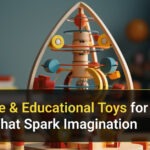In today’s world of ever-evolving technology and innovation, problem-solving has become one of the most valuable skills a child can develop. Whether it’s tackling everyday challenges or building something new from scratch, the ability to think critically and creatively is essential. One of the best ways to nurture these abilities in children is through engineering toys. These toys go beyond entertainment; they engage young minds in hands-on learning, encouraging curiosity, experimentation, and logical thinking.
The Power of Play in Learning
Children learn best through play. It’s during playtime that they explore, make mistakes, and discover how things work. Educational play bridges fun with learning, allowing kids to grasp complex concepts naturally. When kids engage with engineering toys, they’re not just stacking blocks or fitting pieces together; they’re experimenting with design, physics, and cause-and-effect relationships.
For example, when a child builds a bridge using construction pieces, they learn about balance, stability, and weight distribution without realizing they’re learning engineering fundamentals. The process of trial and error, building, testing, and rebuilding cultivates resilience and analytical thinking. These are the same skills that real-world engineers use every day.
How Engineering Toys Encourage Problem-Solving
Problem-solving is not just about finding answers; it’s about exploring possibilities. Engineering kits push children to think independently, ask questions, and develop strategies. Let’s look at a few ways they do this:
Hands-On Experimentation
Engineering-based play invites kids to test ideas in real time. If a structure falls or a gear doesn’t spin, they learn to identify the problem and adjust their approach. This constant iteration fosters analytical reasoning and persistence.
Encouraging Logical Thinking
Building a functioning model requires understanding how different components interact. Whether connecting gears or aligning beams, kids learn logical sequencing, a vital part of problem-solving in any field.
Creativity Meets Structure
Unlike regular toys that may follow a set storyline, engineering kits balance creativity with rules. Children must use logic to make something work while still being free to innovate. This blend of freedom and structure trains them to think both creatively and systematically.
Collaborative Thinking
Many of these toys are designed for group play, which strengthens teamwork and communication. When children collaborate to build a complex model, they learn to share ideas, divide tasks, and combine strengths to solve challenges together.
STEM Learning Through Engineering Play
STEM, Science, Technology, Engineering, and Mathematics, form the foundation of modern education. Engineering play naturally integrates these concepts in a way that feels like fun rather than study.
For example:
- Science: Kids learn about gravity, energy, and motion through ramps, pulleys, or catapult kits.
- Technology: When toys involve sensors or programmable parts, children explore the basics of coding and robotics.
- Engineering: Building bridges, vehicles, or structures teaches balance, design, and mechanics.
- Mathematics: Counting pieces, measuring distances, and estimating weight enhance math skills effortlessly.
In short, engineering toys make the STEM approachable and exciting. They turn abstract theories into hands-on experiences, allowing children to see real-world applications of what they learn in school.
The Role of Failure in Problem-Solving
One of the most powerful lessons engineering-based play teaches is that failure is not the end; it’s part of the journey. When a child’s design doesn’t work, they learn to identify what went wrong and try again. This mindset is critical for success in both academics and life.
Failure builds patience, persistence, and adaptability, key traits of a problem solver. A child who grows comfortable with experimentation will carry that same confidence into other areas of learning and adulthood.
Popular Types of Engineering Kits
There are countless types of engineering toys available today, catering to different age groups and interests. Here are some of the most popular categories that help children develop strong problem-solving skills:
Building and Construction Sets:
These classic toys, like LEGO Technic or magnetic building blocks, introduce the fundamentals of design, symmetry, and balance. They teach children to visualize structures and understand how parts connect to form a whole.
Mechanical Kits:
Toys that involve gears, levers, and pulleys help kids explore motion and mechanics. These sets often mimic real-world machines, encouraging curiosity about how everyday objects work.
Robotics Kits:
Combining coding with construction, robotics kits introduce children to programming logic and automation. Kids can design robots that move, sense obstacles, or even respond to voice commands.
Circuit and Electronics Kits:
For slightly older children, these kits provide insight into how electricity flows through circuits. They can build alarms, lights, and mini gadgets, learning about conductivity and current.
Engineering Puzzles:
Puzzles that require spatial reasoning, pattern recognition, and logic are excellent for problem-solving. They challenge kids to think several steps ahead, improving their focus and patience.
Real-Life Skills Developed Through Engineering Play
Beyond the academic benefits, engineering toys nurture essential life skills that go far beyond childhood.
Critical Thinking:
Kids learn to analyze situations and make data-driven decisions, whether it’s figuring out how to make a bridge stronger or balancing a tower.
Creativity:
By experimenting with new designs or reimagining traditional builds, children learn to innovate and think outside the box.
Teamwork and Communication:
Working together to solve engineering challenges fosters leadership, listening, and cooperation.
Confidence and Independence:
Each successful creation gives children a sense of accomplishment, motivating them to take on bigger challenges.
Attention to Detail:
Precision is vital when pieces must fit or mechanisms must function. Kids develop focus and patience as they work carefully toward a goal.
Choosing the Right Engineering Toys for Your Child
Not every toy suits every child. The best choice depends on your child’s age, interests, and developmental level. Here are a few tips for parents:
- Age-Appropriate Complexity: Choose toys that challenge your child but don’t frustrate them. Younger kids might enjoy simple magnetic tiles, while older ones can handle programmable robotics.
- Open-Ended Design: Look for toys that allow multiple outcomes. Open-ended sets encourage creativity rather than just following instructions.
- Quality and Safety: Durable, non-toxic materials are a must, especially for younger children who explore with their hands and mouths.
- Educational Value: Select toys that align with your child’s school learning or introduce new STEM concepts.
Parents can also play alongside their children. Collaborative play enhances bonding and helps adults guide problem-solving discussions. Asking questions like “Why do you think this didn’t work?” or “What could we change?” encourages deeper thinking.
The Future Engineer in Every Child
Every child is naturally curious. They love to take things apart, see what’s inside, and ask endless questions about how the world works. Engineering toys harness that natural curiosity and turn it into meaningful exploration.
These toys don’t just prepare kids for possible engineering careers; they equip them with a mindset that values discovery, persistence, and logical thinking. Whether they grow up to be engineers, artists, doctors, or entrepreneurs, the ability to solve problems creatively will always be their greatest strength.
Encouraging a Lifelong Love for Learning
In an age where screens dominate playtime, hands-on activities like building, designing, and experimenting are more important than ever. They keep children engaged with the real world, teaching them that learning can be both fun and fulfilling.
Parents and educators should view play not as a distraction from learning but as one of its most powerful forms. Every tower that topples, every gear that jams, and every structure that finally stands tall is a lesson learned, one that builds the foundation for lifelong problem-solving skills.
Final Thoughts
In a world driven by innovation, the need for thinkers, creators, and problem-solvers continues to grow. Encouraging these qualities from an early age can set children on a path to success in any field. Engineering toys are more than just tools for play; they’re stepping stones toward a mindset that embraces challenges, learns from mistakes, and celebrates discovery.
By fostering curiosity, resilience, and critical thinking, these toys build much more than models; they build the engineers of tomorrow.






